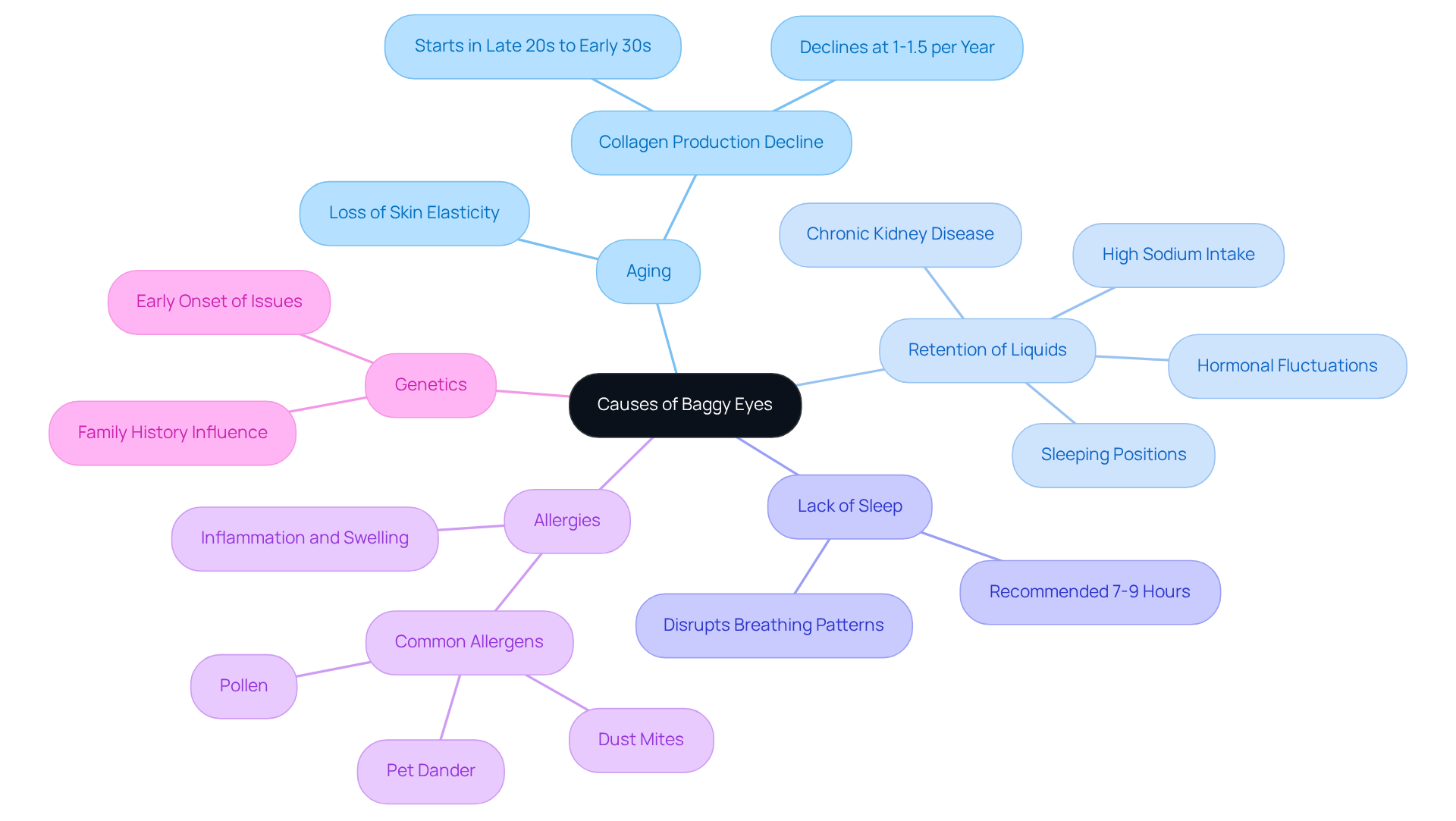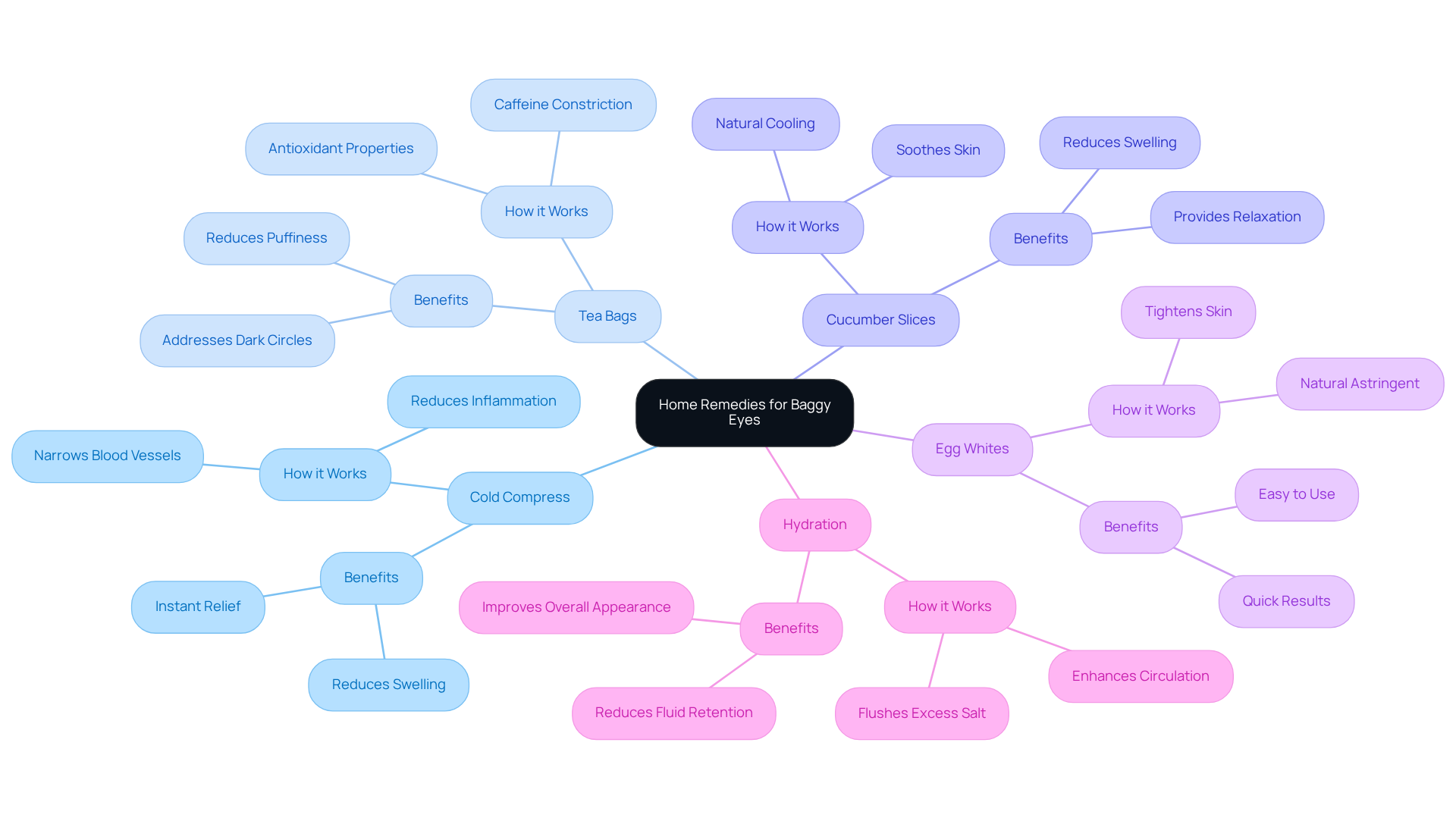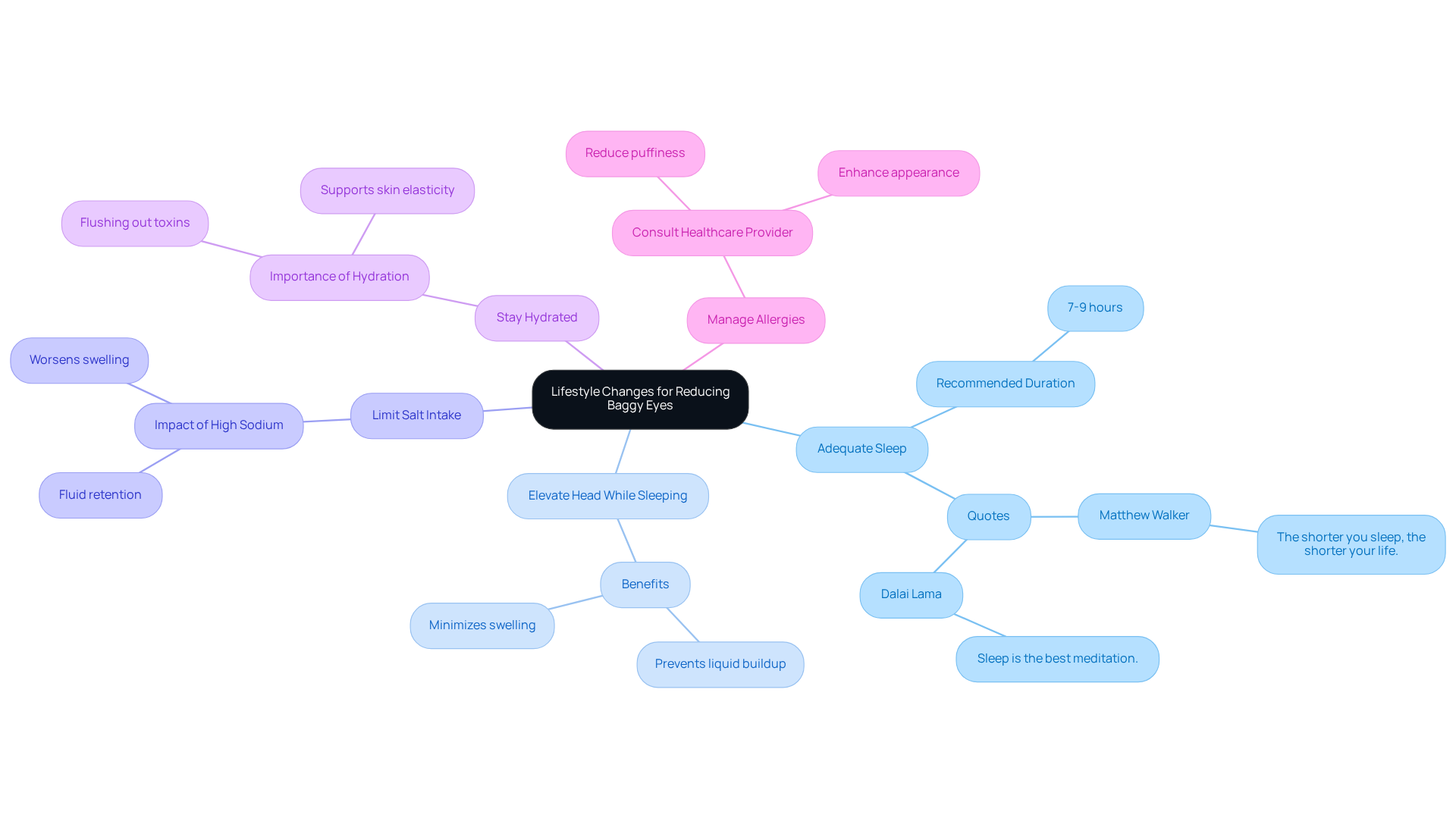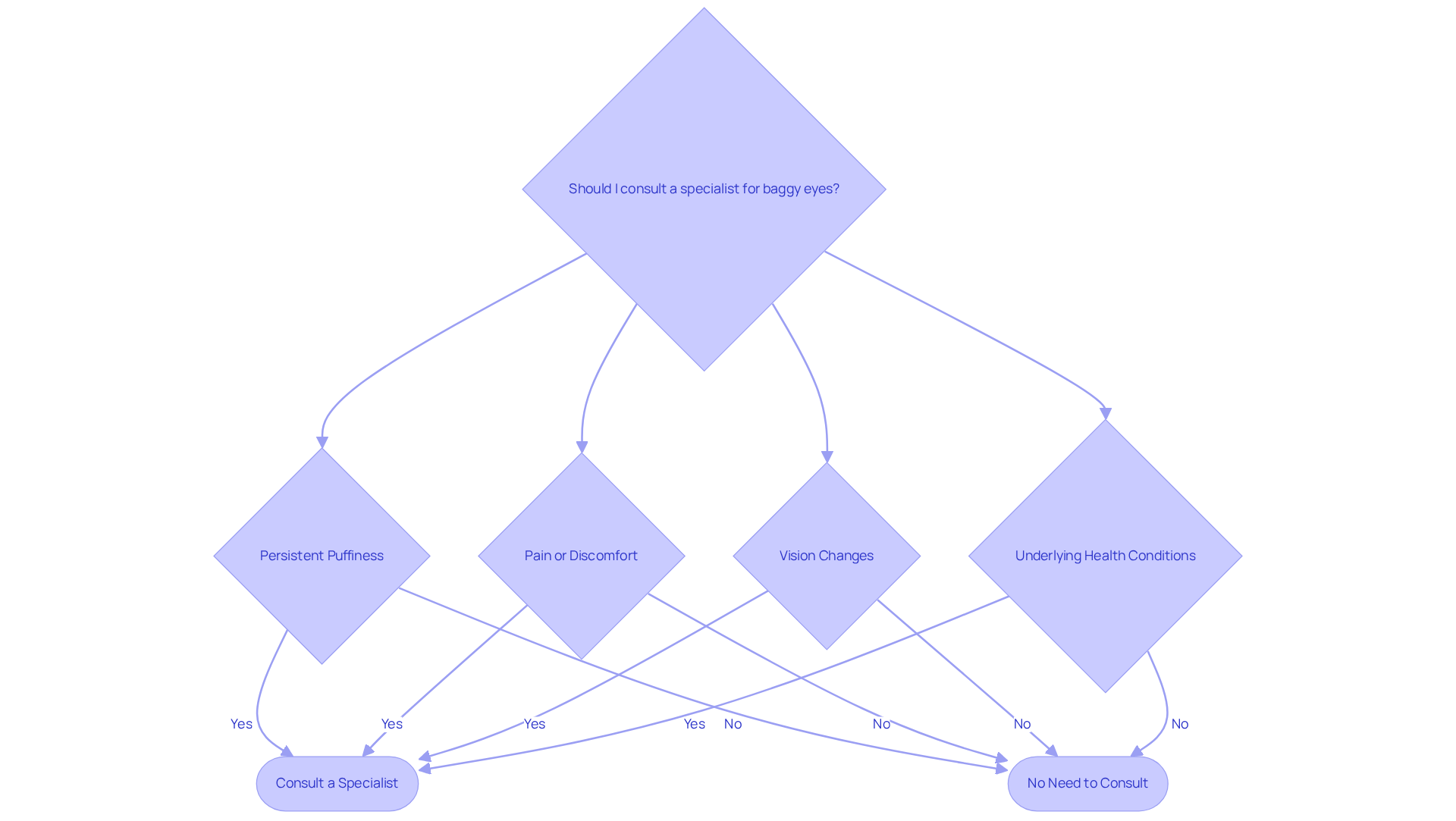Posted by: Northwest Eye in General, Oculoplastic on July 17, 2025
Overview
We understand that dealing with baggy eyes can be a concern for many. This article outlines four effective steps to help you reduce the appearance of baggy eyes:
- Identifying the causes
- Implementing home remedies
- Adopting lifestyle changes
- Recognizing when it might be time to consult a specialist
Each step is thoughtfully supported by detailed explanations of the factors contributing to baggy eyes, as well as practical solutions.
For instance, using cold compresses can provide immediate relief, while maintaining proper hydration and ensuring adequate sleep are essential for long-term improvement. These collective efforts aim to enhance your youthful appearance and restore your confidence. Remember, you are not alone in this journey, and we are here to help you through it.
Introduction
Understanding the causes of baggy eyes can be the first step toward reclaiming a youthful appearance. We understand that factors such as aging, lack of sleep, and even dietary choices can contribute to this common concern, leaving many searching for effective solutions. This article delves into practical steps that not only address the visibility of under-eye bags but also enhance overall skin health.
What if the secret to a refreshed look lies in simple lifestyle changes and home remedies? Exploring these strategies could lead to a significant transformation in your appearance and confidence. We are here to help you through this process.
Identify Causes of Baggy Eyes
A variety of factors can lead to baggy eyes, and we understand how concerning this can be. Here are some common causes:
- Aging: As we age, our skin’s elasticity diminishes, leading to sagging and the development of bags under the eyes. Research indicates that collagen production begins to decline in the late 20s to early 30s at a rate of 1%-1.5% per year, contributing to this issue.
- Retention of Liquids: High sodium intake, hormonal fluctuations, and even sleeping positions can lead to accumulation around the eyes. High salt intake is especially notorious for causing puffiness, as it disrupts the body’s moisture balance. Additionally, chronic kidney disease can contribute to periorbital edema due to fluid balance issues.
- Lack of Sleep: We know that insufficient rest can significantly worsen the visibility of baggy eyes. Adults typically require 7-9 hours of sleep per night to maintain optimal eye health and reduce puffiness.
- Allergies: Allergic responses frequently lead to inflammation and swelling around the orbits, worsening the appearance of bags. Common allergens include dust mites, pollen, and pet dander.
- Genetics: Family history plays a crucial role in the likelihood of developing sagging skin beneath the eyes. Individuals with a genetic predisposition may experience these issues at a younger age, highlighting the influence of inherited traits on skin aging and collagen production.
Understanding these causes is crucial for effectively addressing and reducing the impacts of baggy eyes. Additionally, maintaining hydration by consuming 8-10 glasses of water each day can assist in minimizing fluid retention around the orbits. Remember, we are here to help you through this process.

Implement Effective Home Remedies
Applying efficient home treatments can greatly diminish the visibility of baggy eyes beneath the skin. We understand that dealing with under-eye bags can be frustrating, and we’re here to offer some tried-and-true methods that might help you feel more confident:
- Cold Compress: We recommend applying a cold compress, such as a chilled spoon or a clean washcloth soaked in cold water, to the under-eye area for 10-15 minutes. This can effectively reduce swelling. Cold compresses work by narrowing blood vessels and reducing inflammation, offering instant relief. However, it’s important to avoid using a cold compress for longer than 20 minutes to prevent frostbite, as advised by the Rand Eye Institute.
- Tea Bags: Caffeinated tea bags, particularly green or black, can be a powerful remedy. After steeping and cooling, place the tea bags over your eyelids for about 15 minutes. The caffeine helps constrict blood vessels, reducing puffiness and dark circles. Many skincare specialists recommend this method, and Dr. Blair Murphy-Rose notes its effectiveness for addressing baggy eyes.
- Cucumber Slices: Chilled cucumber slices are not just refreshing; they also soothe the skin and reduce swelling due to their natural cooling properties. This simple remedy can be a delightful addition to your skincare routine, providing a moment of relaxation.
- Egg Whites: Whisking egg whites and applying them under your eyes can act as a natural astringent, temporarily tightening the skin. This method is favored for its quick results and ease of use, making it a convenient option.
- Hydration: Staying well-hydrated is crucial. Drinking plenty of water helps flush out excess salt from your system, reducing fluid retention that contributes to under-eye bags. Proper hydration enhances circulation, which can further help in reducing puffiness.
Integrating these solutions into your daily schedule can lead to significant enhancements in the look of puffiness, boosting your overall youthful appearance. Remember, we are here to help you through this process, and it’s common to seek support as you explore these options.

Adopt Lifestyle Changes for Lasting Results
To achieve lasting results in reducing baggy eyes, we recognize that implementing certain lifestyle changes can be immensely beneficial. Here are some thoughtful suggestions to consider:
- Get Adequate Sleep: Aim for 7-9 hours of quality sleep each night. As sleep researcher Matthew Walker emphasizes, “The shorter you sleep, the shorter your life.” Adequate rest is essential for your body to recuperate and can greatly reduce baggy eyes. Quality sleep not only rejuvenates the skin but also enhances overall eye health, allowing the brain to clear toxins and strengthen neural connections.
- Elevate Your Head While Sleeping: Consider using an extra pillow to keep your head elevated during sleep. This simple adjustment can help prevent liquid buildup around the eyes, minimizing the appearance of swelling.
- Limit Salt Intake: Reducing salt in your diet is important, as high sodium levels can lead to fluid retention, worsening swelling. Monitoring your salt intake is a straightforward yet effective strategy for maintaining a youthful look.
- Stay Hydrated: Drinking plenty of water throughout the day is vital for flushing out toxins and minimizing swelling. Proper hydration supports skin elasticity and overall eye health. As the Dalai Lama states, “Sleep is the best meditation,” and staying hydrated complements this by ensuring your body functions optimally.
- Manage Allergies: If allergies contribute to your symptoms, we encourage you to consult with a healthcare provider for appropriate treatments. Managing allergy triggers can significantly reduce puffiness and enhance the appearance of your eyes.
By implementing these thoughtful changes, you can achieve a significant decrease in the visibility of baggy eyes over time, improving your overall appearance and boosting your self-confidence.

Recognize When to Consult a Specialist
While many instances of baggy eyes can be alleviated through home remedies and lifestyle adjustments, we understand that it is crucial to recognize when to seek professional help.
- Persistent Puffiness: If you have baggy eyes that persist despite home treatments or lifestyle changes for several weeks, it’s common to feel concerned. It may be time to consult a specialist.
- Pain or Discomfort: Experiencing pain, redness, or irritation in the eye area is a clear indicator that professional evaluation is necessary. We care about your comfort and want to ensure your well-being.
- Vision Changes: Any alterations in vision or accompanying symptoms like headaches should prompt an immediate visit to an eye care professional. It’s important to prioritize your health.
- Underlying Health Conditions: A history of thyroid issues, kidney problems, or other health concerns can lead to baggy eyes. If this resonates with you, seeking expert advice is essential.
Consulting a specialist not only offers tailored treatment options but also provides peace of mind regarding your eye health. Remember, we are here to help you through this process.

Conclusion
Understanding and addressing the issue of baggy eyes is crucial for achieving a youthful appearance. We understand that this concern can be distressing, and by recognizing the various causes—from aging and fluid retention to lack of sleep and genetic factors—we can take informed steps to mitigate it. The journey to reducing puffiness involves not only identifying these underlying issues but also implementing effective home remedies and lifestyle changes.
Key strategies include:
- The use of cold compresses
- Tea bags
- Simple dietary adjustments to combat fluid retention
It’s common to feel overwhelmed, but emphasizing the importance of adequate sleep and hydration enhances these efforts, promoting skin elasticity and overall eye health. Additionally, recognizing when to seek professional help ensures that persistent or concerning symptoms receive appropriate attention, safeguarding both comfort and well-being.
Ultimately, tackling baggy eyes is about more than just aesthetics; it reflects a commitment to self-care and health. By integrating these practical tips and being proactive about eye health, you can significantly boost your confidence and embrace a more vibrant appearance. Taking these steps not only helps in reducing puffiness but also fosters a sense of empowerment in managing your health and beauty routines. Remember, we are here to help you through this process.
Frequently Asked Questions
What are the common causes of baggy eyes?
Common causes of baggy eyes include aging, retention of liquids, lack of sleep, allergies, and genetics.
How does aging contribute to baggy eyes?
As we age, the skin’s elasticity diminishes, leading to sagging and the development of bags under the eyes. Collagen production declines starting in the late 20s to early 30s, contributing to this issue.
What role does liquid retention play in the appearance of baggy eyes?
Liquid retention can occur due to high sodium intake, hormonal fluctuations, and sleeping positions, leading to accumulation around the eyes. High salt intake disrupts the body’s moisture balance, contributing to puffiness.
How does lack of sleep affect baggy eyes?
Insufficient rest can significantly worsen the visibility of baggy eyes. Adults typically need 7-9 hours of sleep per night to maintain optimal eye health and reduce puffiness.
Can allergies cause baggy eyes?
Yes, allergic responses can lead to inflammation and swelling around the eyes, worsening the appearance of bags. Common allergens include dust mites, pollen, and pet dander.
Is there a genetic factor in developing baggy eyes?
Yes, family history plays a crucial role in the likelihood of developing sagging skin beneath the eyes. Individuals with a genetic predisposition may experience these issues at a younger age.
What can be done to minimize fluid retention around the eyes?
Maintaining hydration by consuming 8-10 glasses of water each day can assist in minimizing fluid retention around the orbits.






